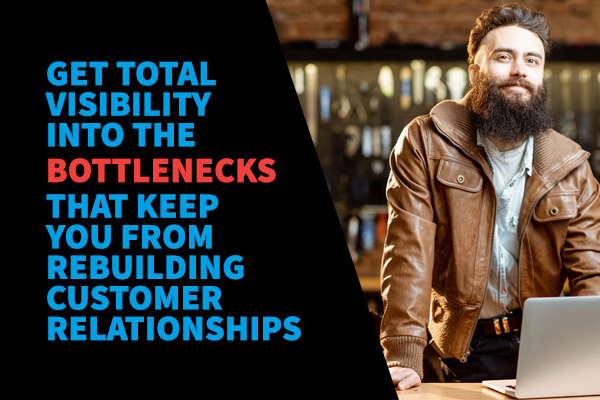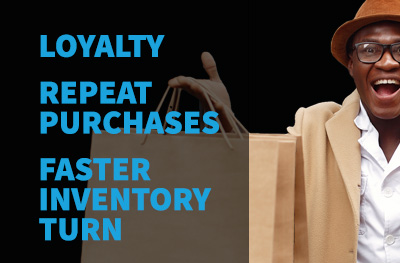6 Ways to connect your physical and digital store operations for better omnichannel experiences

The struggle is real for customers hoping to take some of the legwork out of shopping by researching products online before heading to a store – only to make the drive and discover the product they decided on isn’t available, as it is in omnichannel experiences they have at other stores.
For retailers, such deflating experiences can mean a loss of loyal customers as well as a damaged reputation.
As shoppers become more strapped for leisure time and less willing to browse for hours just for fun, connecting a physical and digital store experience is increasingly critical for retail longevity.
It’s all about what some refer to as Retail FOMO: That is, customers’ fear of missing out on things they want, and retailers’ fear of missing a sale.
Here are 6 ways you can connect your physical and digital store experiences with Retail Pro Prism POS and retail management software to remove some of the friction shoppers are experiencing while retailers are building their omnichannel strategies.
1. Show in-store stock availability online

Research suggests that roughly a quarter of customers won’t visit a store if they aren’t sure what they are looking for is available. In addition, more than half will leave a store disappointed if they can’t find the item they had in mind.
One way to avoid that is by showing customers stock availability online. That way e-window shoppers can be assured that what they are looking for is available when they visit.
And, in the unfortunate case that a particular item is sold moments before a shopper arrives, enabling in-store ordering for free home delivery is one way to compensate the customer.
Retail Pro Prism has accessible APIs and hundreds of Plugins and integrations on the Retail Pro App Market to help retailers connect their ecommerce with inventory information in Retail Pro.
The ability to straightforwardly integrate any technology retailers already use (or might choose to use in the future) gives retailers control over decisions like which platform will be the data master through which they’ll reference and report on stock availability and needs across all their store locations, including ecommerce.

Challenges of using store inventory for online order fulfillment
2. Show off your full selection with endless aisle

Endless aisle can accommodate retailers that, often because of a small physical footprint, can’t stock a wide range of products.
The technology lets customers virtually browse or order a wide range of products that are either out of stock or not sold in-store and have them shipped to the store or their home.
Because Retail Pro Prism is browser-based software and not solely a mobile or desktop app, retailers can run Retail Pro both on their desktop computer or laptop at the till – or on an iPad or other mobile device so that sales associates can access inventory information when helping customers on the sales floor.
So when a product is not available at this store, sales associates can easily show customers the item images for the product they want and place an order for them, saving the sale.

The practicality of endless aisle when supply chain delays cause in-store stockouts
3. Give them an occasion to shop in-store

Happy couple looking at big shop display
In addition to providing a better customer experience, providing inventory information drives customers into stores, opening the door to additional purchases.
Impulse buys are more common for shoppers at brick-and-mortar retailers, because those stores can influence customer shopping experiences by tailoring layout and staffing decisions based on their clientele.
According to A.T. Kearney, 40 percent of customers make unplanned purchases at physical stores and spend more money, compared to 25 percent of online shoppers.
4. Reward their loyalty across channels
Aligning physical and digital stores also means ensuring that shopping benefits are equivalent.
Loyalty rewards should be earned in the same manner, for example, and coupons should be valid online and in-person. Being a rewards member should be the ultimate frictionless experience.
Using an integrated loyalty platform like AppCard or OptCulture with Retail Pro Prism not only saves your associates and customers time at checkout when handling loyalty, but also ties in the POS transaction data with your loyalty platform so you can run campaigns based on actual purchase data.

Measuring ROI of relationship building with loyalty programs
5. Work out the kinks for online returns in-store
Despite the best intentions of retailers and customers, sometimes merchandise must be returned. How a retailer handles this onerous process with the customer is reflective of its overall commitment to customer service.
By working through the kinks for in-store returns of online purchases, retailers can offer their shoppers a less stressful initial purchasing experience, because they are assured that if they are unsatisfied, returning is a simple process.
Because all inventory items (whether online or in-store) would have been created in Retail Pro Prism and then used to populate a retailer’s online inventory when integrated, retailers will be able to accept the online inventory without the backend hassle of accounting for online versus in-store purchase origin.
Once the item is returned, it can be assimilated into the physical store inventory, accounted for and ready to be resold.
6. Help your store staff get to know your omnichannel shoppers
When a customer begins a journey online, or has a history of shopping through a retailer’s online channel, that data can and should be used to personalize the in-store shopping experience.
By analyzing and connecting transactional data from their Retail Pro POS into one holistic view, retailers can learn how often a customer shops, what they purchased, where they are from, how much they spend across different channels, and whether they are new or repeat buyers.
That can help inform associates in the physical store as they engage with shoppers, as well as help form future decisions for an omnichannel product and customer engagement strategy, especially when retailers use an integrated business intelligence and visual analytics solution with the rich data they collect at the Retail Pro Prism point of sale.
The information conduit flows both ways now, not just as a funnel into one channel or another, so retailers can fix broken customer journeys and convert more sales, improve efficiency and increase loyalty.
Bringing both worlds together – digital and physical – will mean some parts of the journey will still have bumps along the way.
But addressing the operational challenges in each of these areas will help retailers smooth some of the friction that arises as they build their omnichannel strategy.
Optimizing the omnichannel experience in your stores? Let’s talk.
Request a consultation with an Authorized Retail Pro Business Partner in your region or watch a brief demo of Retail Pro Prism today to see how you can transform the luxury experience in-store with omnichannel operations built on with Retail Pro Prism.




